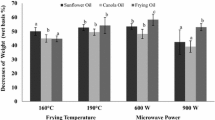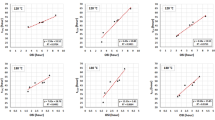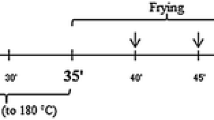Abstract
A study was conducted to compare the relationship between frying stability and levels and degradation rates of tocopherols in regular and three modified canola oils. Oils were heated at 175 ± 2°C for a total of 72 h, with french fries fried intermittently. Frying stability was compared based on the rates of formation of free fatty acids (FFA) and total polar compounds (TPC). Significant differences (P<0.05) were identified between oils using analysis of covariance and t-tests for multiple comparisons. No significant differences were observed in the rates of FFA formation among the canola oils during frying. Nevertheless, regular canola (RCO) and high-oleic, low-linolenic acid canola (HOLLCO) oils produced less FFA compared to higholeic LLCO and HOCO both had significantly (P<0.05) faster rates of TPC formation compared to HOLLCO or RCO. HOLLCO with the highest level of tocopherols (893 mg/kg) exhibited a slow rate of degradation which accounted for a halflife of 48–60 h of frying. RCO, with a lower level of tocopherols (565 mg/kg), however, had the slowest degradation rate with a half-liofe of >72 h. In contrast, HOCO and LLCO with 601 and 468 mg/kg tocopherols, respectively, both exhibited a half-life for tocopherols of 3–6 h of frying. An inverse relatioship was observed between TPC formation and the reduction of tocopherol. Thus, the greater frying stability of RCO and HOLLCO appears to be affected far more by the rate of tocopherol degradation than by any changes in fatty acid composition.
Similar content being viewed by others
References
Eskin, N.A.M., M. Vaisey-Genser, S. Durance-Todd, and R. Przybylski, Stability of Low Linolenic Acid Canola Oil to Frying Temperatures, J. Am. Oil Chem. Soc. 66:1081–1084 (1989).
Dobarganes, M.C., G. Marquez-Ruiz, and M.C. Perez-Camino, Thermal Stability and Frying Performance of Genetically Modified Sunflower Seed (Helianthus annuus L.) Oils, J. Agric. Food Chem. 41:678–681, (1993).
Liu, H., and P.J. White, High-Temperature Stability of Soybean Oils with Altered Fatty Acid Composition, J. Am. Oil Chem. Soc. 69:533–537 (1992).
Warner, K., and T.L. Mounts, Frying Stability of Soybean and Canola Oils with Modified Fatty Acid Composition, Ibid. 70:983–988 (1993).
Romero, A., F.J. Sánchez-Muniz, C. Tulasne, and C. Cuesta, High-Performance Size-Exclusion Chromatographic Studies on a High-Oleic Acid Sunflower Oil During Potato Frying. Ibid. 72:1513–1517 (1995).
Mounts, T.L., K. Warner, and G.R. List, Performance Evaluation of Hexane-Extracted Oils from Genetically Modified Soybeans, Ibid. 71:157–161 (1994).
Mounts, T.L., K. Warner, G.R. List, W.E. Neff, and R.F. Wilson, Low-Linolenic Acid Soybean Oils—Alternatives to Frying Oils, Ibid. 71:495–499 (1994).
Xu, X-Q., V.H. Tran, M. Palmer, K. White, and P. Salisbury, Chemical and Physical Analyses and Sensory Evaluation of Six Deep-Frying Oils, Ibid. 76:1091–1099 (1999).
Morton, I.D., and J.E. Chidley, Methods and Equipment in Frying, in Frying of Food: Principles, Changes, New Approaches, edited by G. Varela, A.E. Bender, and I.D. Morton, Ellis Harwood Ltd., (Chichester) 1988, pp. 37–51.
Arroyo, R., C. Cuesta, C. Garrido-Polonio, S. Lopez-Varela, and F.J. Sanchez-Muniz, High-Performance Size-Exclusion Chromatographic Studies on Polar Components Formed in Sunflower Oil Used for Frying, J. Am. Oil Chem. Soc. 69:557–563 (1992).
Arroyo, R., C. Cuesta, J.M. Sanchez-Montero, and F.J. Sanchez-Muniz, High-Performance Size-Exclusion Chromatography of Palm Olein Used for Frying, Fett Wiss. Technol. 97:292–296 (1995).
Lopez-Valera, S., F.J. Sanchez-Muniz, C. Garrido-Polonio, R. Arroyo, and C. Cuesta, Relationship Between Chemical and Physical Indexes and Column and HPSE Chromatography Methods for Evaluating Frying Oil, Z. Ernaehrungswiss. 34:308–313 (1995).
Peroxide Value (Acetic Acid-Chloroform Method), in Official and Tentative Methods of the American Oil Chemists’ Society, American Oil Chemists’, Society, (Champaign) 1990, Method Cd 8-53.
Fatty Acid Composition by Gas Chromatography, in Ibid. Official and Tentative Methods of the American Oil Chemists’ Society, American Oil Chemists’ Society, (Champaign) 1990, Method Ce 1-62.
Normand, L., N.A.M. Eskin, and R. Przybylski, Evaluation of the Veri-Fry® Pro FFA-75 Quick Test for Measuring Free Fatty Acids in Deep-Frying Oils, J. Food Lipids 7:63–69 (2000).
Petukhov, I., Frying Performance and Storage Stability of Potato Chips Fried in Genetically Modified Canola Oils, M.Sc. Thesis, The University of Manitoba, Winnipeg, 1986.
Sebedio, J.L., C. Septier, and A. Grandgirard, Fractionation of Commercial Frying Oil Samples Using Sep-Pak Cartridges, J. Am. Oil Chem. Soc. 63:1541–1543 (1986).
Polar Components in Frying Fats-Chromatographic Method, in Official Methods of Analysis of the Association of Official Analytical Chemists. Food Composition; Additives; Natural Contaminants. Vol. Two, 15th edn., edited by K. Helrich, Association of Official Analytical Chemists, Inc., 1990, 968–969 (Arlington).
Determination of Tocopherols and Tocotrienols in Vegetable Oils and Fats by HPLC, in Official and Tentative Methods of the American Oil Chemists’ Society, American Oil Chemists’ Society, Champaign, 1990 Official Method Ce 8-89.
Determination of Copper, Iron, Nickel by Direct Graphite Furnace Atomic Absorption Spectrometry, in Ibid. Official and Tentative Methods of the American Oil Chemists’ Society, American Oil Chemists’ Society, Champaign, 1992, Offical Method Ca 18b-91.
Orthoefer, F.T., and D.S. Cooper, Initial Quality of Frying Oil, in Deep Frying, Chemistry, Nutrition, and Practical Applications, edited by E.D. Perkins and M.D. Erikson, AOCS Press, Champaign, 1996, pp. 29–42.
Dobarganes, M.C., and G. Marquez-Ruiz, Dimeric and Higher Oligomeric Triglycerides, in Ibid., pp. 89–111.
Erickson, M.D., and N. Frey, Property-Enhanced Oils in Food Applications, Food Technol. 48:63–66, 68 (1994).
Madhavi, D.L., R.S. Singhal, and P.R. Kulkarni, Technological Aspects of Food Antioxidants, in Food Antioxidants—Technological, Toxicological, and Health Perspectives, edited by D.L. Madhavi, S.S. Deshpande, and D.K. Salunkhe, Marcel Dekker, Inc., New York, 1996, pp. 159–265.
Syvaoja, E.-L., V. Piironen, P. Varo, P. Koivistoinen, and K. Salminen, Tocopherols and Tocotrienols in Finnish Foods: Oils and Fats, J. Am. Oil Chem. Soc. 63:328–329.
Warner, K., P. Orr, L. Parrott, and M. Glynn, Effects of Frying Oil Composition on Potato Chip Stability, Ibid. 71:1327–1331 (1994).
Li, W., Phytosterol and Tocopherol Changes in Modified Canola Oils During Frying and Storage of Fried Products, M.Sc. Thesis, 1996, The University of Manitoba.
Gordon, M.H., and L. Kourimska, Effect of Antioxidants on Losses of Tocopherols During Deep-Fat Frying, Food Chem. 52:175–177 (1995).
Author information
Authors and Affiliations
Corresponding author
About this article
Cite this article
Normand, L., Eskin, N.A.M. & Przybylski, R. Effect of tocopherols on the frying stability of regular and modified canola oils. J Amer Oil Chem Soc 78, 369–373 (2001). https://doi.org/10.1007/s11746-001-0270-7
Received:
Accepted:
Issue Date:
DOI: https://doi.org/10.1007/s11746-001-0270-7




